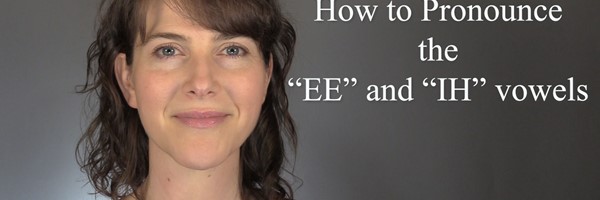(Video Transcript)
In an earlier video, I discussed how to pronounce the vowel pair EE as in beat and IH as in bit, with EE as the tense vowel, which means there is more tension in the throat, face, and tongue when you say this sound. And IH as the lax vowel, which means there is less tension, and your throat, face, and tongue are more neutral. Today I’ll talk about how to pronounce another tense/lax vowel pair, the AY as in bait and EH as in bet vowels.
AY /eɪ/ vs. EH /ɛ/: IPA Symbols
One of the first things you’ll notice when you see the IPA symbols for AY and EH is that AY has two symbols /e͡ɪ/, while EH has only one /ɛ/. This is because AY is a diphthong vowel (di = two), which means it is one sound that is created by the combination of two vowels. It begins as one vowel /e/ and moves towards another vowel /ɪ/. In fact, when you say the vowel AY, you should feel movement in your jaw, lips, and tongue as you move through the sound. AY, AY.
The AY /eɪ/ Vowel
The AY vowel is in the words may, late, and date. To say the AY vowel, start with the mouth open and jaw dropped down. The tongue should be lower in the mouth, with the tip resting just behind the bottom front teeth. The lips should be neutral to begin or slightly spread apart. It should look like this.
Then as you progress to the second part of the sound, the jaw should close, the tongue should rise just a bit, and your lips should spread. You should also feel tension in the tongue, lips, and underneath the chin (place your hand under your chin to feel this). AY, AY. It should look like this.
AY is considered a tense vowel because of the extra tension that is felt within the articulators and under the chin. This tension should help you to distinguish the AY sound from the lax vowel, EH.
The EH /ɛ/ Vowel
While the AY vowel is called a diphthong, the EH vowel is called a monophthong (mono = one). This means the EH vowel contains just one sound.
The EH vowel is in the words red, head, and bed. To make the EH sound, drop the jaw a bit lower than for AY. The tongue should also be lower in the mouth and more relaxed. If you place your hand underneath your chin, you should feel less muscular effort than you did with AY. Your mouth should look like this.
When you first practice these two vowels, try to exaggerate the movement of AY until you are positive that you can feel it. Also use a mirror so that you can see the movement in the jaw and tongue. And remember - there shouldn’t be any movement with EH because EH is a monophthong - just one sound.
Practice Words and Sentences
Here are some practice words and sentences to help you with AY and EH. I’ll read the sentence at my normal pace, and then I’ll show you a close up of my mouth as I say the words. Pay attention to my jaw, lips, and tongue placement.
mate, met
My mate and I met at the party.
late, let
I’m sorry I’m late; please let me inside.
bail, bell
My husband paid my bail, so I rang the bell.
raid, red
The red ants have raided my pantry!
date, debt
I can’t go on this date because I’m in too much debt.
Thanks for watching! And I'd love to hear from you - contact me to learn how we can work together to perfect your American English pronunciation!


